Grandes Jorasses, Directe de l'Amitié by Corrado Pesce and Martin Elias
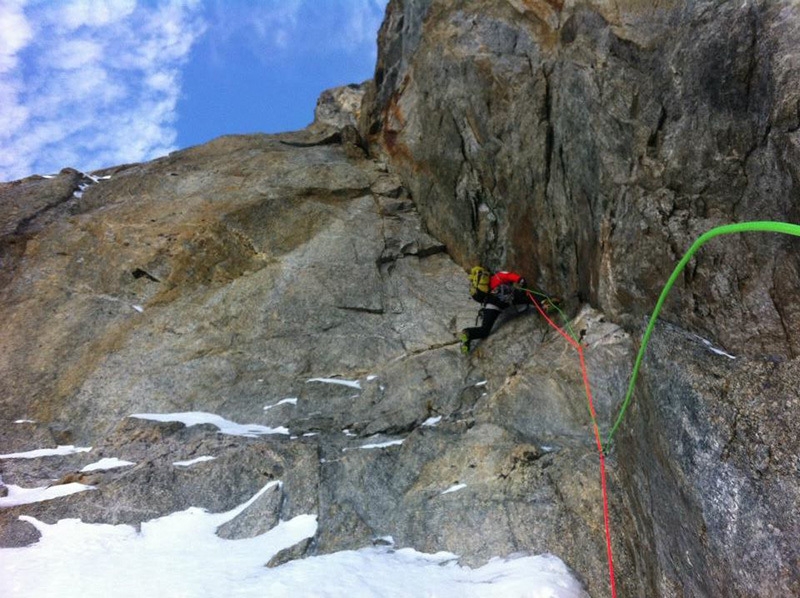
 1 / 13
1 / 13 Corrado Pesce & Martin Elias
Corrado Pesce & Martin Elias
With its countless jutted peaks, rocky spurs, gullies and walls, the North Face of the Grandes Jorasses certainly doesn't deserve to be remembered for just one route. On the contrary, it is due to the incredibly diverse nature of its routes that this peak has attracted climbers worldwide for more than a century. Great spurs tower towards the various summits and were conquered one by one, the last of which, leading to Pointe Whymper, prompted the great Walter Bonatti to imagine a future far removed from cutting-edge alpinism. The route climbed by Bonatti and Vaucher - one of the most daring at the time and even today an utterly committing outing - was however not the solution to the problem presented by the overhanging Whymper face.
The decision to solve the problem in winter, without wasting resources or energy, was taken by Louis Audubert and Yannick Seigneur. While the former had made the winter ascent of the Peuterey Integral the previous year, the latter was driving force behind French success on the SW Pillar of Makalu in 1971. Joined by Marc Galy and Michel Feuillarade, the North Face was confronted using the same siege tactics that had proven so successful on the North Face of the Eiger's John Harlin Direct and the Japanese Direct, two routes of similar stature to the new project. A base camp was established, ropes were fixed, hundreds of pegs pounded and external help, via porter support, were all needed to get to grips with this terrible face. In truth this veritable expedition was successful largely because of the tenacity of these alpinists who, with great courage, dealt with very difficult conditions on the face that, even in the mildest winters, is an extremely cold and isolated place to be. And that January 1974 proved to be particularly cold.
During the 20 days needed to establish the new route the four French swung leads, forging their line up ice (pitches similar in angle to those on the Dru North Couloir, first ascended ten days earlier in beautiful style), friable overhangs and the hallmark Grandes Jorasses treacherous mixed terrain. Audoubert suffered terrible toothache, Seigneur took a 15m fall, they all jumared for miles and shivered through horrendous bivies while enduring raging storms and the biting cold. This is how Directe de l'Amitié came into being, the most difficult climb in the massif. This route was criticised, wrongly, and no mention was made of the stubbornness and perseverance of the first ascentionists. In truth though, ascents that leave room for stylistic improvement are all the more interesting for those who eventually repeat them.
The first repeat was carried out in September 1977 by Nick Colton and Roger Baxter-Jones, two Englishmen who formed part of a large group of talented alpinists who had colonized a plot of land, Snell's field, located within Bois du Bouchet, the forest between Chamonix and Les Praz. The group included some of the greatest mountaineers of that era, those who would later pioneer Alpine Style in the Himalaya, such as Alex McIntyre, or great free climbers such as Tobin Sorenson, a member of the prodigious Stonemasters group. Thy had a never-ending list of projects and the most interesting of all seemed to be connected to repeating the most difficult routes as "clean" as possible, a concept that is often wrongly used nowadays but which, at the time, represented a true change in direction, a standpoint and distinctive move away from wanting to establish a new route regardless of the cost. The routes the group had in mind were La Directe de l'Amitié, the Desmaison route and the Harlin Direct.
Nick Colton and Roger Baxter-Jones made their way to the Leschaux refuge intent on climbing the route put up by Rene (Desmaison, ed), but were forced to change plans once they found out that Sorenson and Gordon Smith were about to succeed in their repeat. Hence they opted for the Directe de l'Amitié and this is what Colton had to say about the ensuing ascent: "we went on Directe de l'Amitié and did the line in 5 days, which was a very long time for us. We carried big sacs which meant we had to aid a lot of the climb – especially where it was steep. We also ran out of food and our girlfriends called for a helicopter as we didn’t return by the time we had stated we would. The helicopter came and hovered above us on our way down into Italy, just below the summit. Roger and I were not sure what to do but after discussion we decided to send the helicopter away and walk down ourselves on the grounds that if we were trying to do the climb in a better style than those who did the first ascent then we really shouldn’t use a helicopter to get down."
A month later the John Harlin route on the Eiger was climbed clean by McIntyre and Sorenson, meaning that in just one month in 1977 these three great problems were solved; alpinism had reached its apex. Curiously, just as something different, not necessarily better was brewing on the horizon: helicopter assisted solo climbs, extreme bolt-protected slabs, steep skiing. There's a real rift between the alpinism that took place on Mont Blanc during the late 70's and that of the 80's, but the ideal, the quest to climb the most difficult routes as clean as possible remains, and is the force that at the start of the new millennium drove a large number of French alpinists to rediscover these testing grounds. A search for an alpinism that is perhaps less flashy, but more honest.
The third ascent of Directe de l'Amitié was made in 1994 by the strong team comprised of Fauquet, Vimal, Rhem, Escoffier. The Frenchmen climbed the face in summer, predominantly free and with some fast aid, taking advantage of the dry conditions and the long summer days; with their gear reduced to a bare minimum they were pinned down by a storm below the summit and exited the next morning. This was no doubt an impressive undertaking by these talented climbers, extremely efficient on this sort of terrain. The fourth and fifth ascents were made in 1998 during a competition organised by the Russian Mountaineering Federation: several teams of climbers assaulted the difficult routes on the Grandes Jorasses. Soldatov and Sibaev repeated Amitié in four days while Devi and Klenov, the partnership that has made unbelievable ascents on the world's biggest faces, climbed it in just two days and descended on day three.
These two ascents give a great indication as to the Russians' ability at climbing this sort of terrain efficiently, rapidly dealing with any obstacles that may lie in their path. Often wrongly criticised, their ascents on certain Himalayan giants prove that in order to climb extremely difficult faces at altitude, one needs to train on other, similar faces elsewhere. It certainly isn't running up snow slopes and jumping off with a paraglider to then go cragging that you manage to solve the biggest problems in the Himalayas.
After a capsule style attempt that ended in a rescue just a few pitches below the summit, the first lightweight, winter ascent had to wait until 2005 when the day's leading experts of winter ascents on the Jorasses, Stephane Benoist, Patrice Glairon-Rappaz and Paul Robach, breached the face in 6 days. They confirmed the difficulties of the aid pitches, the absolute steepness of the route and the general lack of bivy places. It seems as if after their ascent no one has made another serious attempt at repeating this route.
SEPTEMBER 2014
Looking at the poster hanging in my kitchen, it's the Directe de l'Amitié that most fascinates me most of all, not only because it's not only a really impressive line, but also because there's so little information about it. I'm really motivated this year, especially since conditions are truly special, but I certainly don't want to find myself in the midst of many other parties. Even though this autumn has made the mountain less isolated and more humane, all one needs to do is to move away from the usual routes to regain that sense of inhospitality that characterizes this face. Our weapons are much more efficient than those used by Audoubert & Co, so we decide to deal with the face fast and light, as my heroes from the '70's would have, despite the fact that the forecast four days of good weather could allow us to haul an enormous bag full of goodies and gear that would give us a far better chance of success.
My friend Martin Elias and I want to celebrate our friendship, follow in the footsteps of our pioneers and, quite possibly, work our asses off, just like the first ascentionists. Elias comes from Spain, knows the Spanish Pyrenees like the back of his hand, but also the Jorasses. Like me he's climbed the North Face a number of times this autumn, always fast and efficiently. With its aid pitches, its "doubtful" rock and horrendous bivvies this route must surely please the Pyrenees folk (Audoubert is a legend of the Pyrenees). We really strive for success, but we decide to apply the lessons we'll learn from this climb to future trips in the southern hemisphere where we certainly won't be able to count on four days of good weather. So no hammock (easier said than done when sitting comfortably on a couch). And instead, we opt for a Camalot 5 as recommended by those who repeated the route last. But it weighs a ton... so out with a cartridge of gas. Aiders remain at home, but we'll take some pegs instead. We end up with two decent-sized rucksacks that won't need hauling. We hope we haven't messed up our strategy, it's just snowed and the face is covered in white stuff. Will a day of northerly winds suffice?
The night before setting off I read Audoubert's story once again and, filled with fear, add a down jacket and some extra food. The view from below is reassuring,. The route overhangs, there's not too much snow and we joke about the fact that a bit of snow might make certain falls less painful... Night falls and then the mood becomes more serious, tension gets the upper hand, I really want to do this route and can't fall asleep. The alarm clock doesn't wake me it, it simply prompts me to leap out of bed, action at last! We ascend the glacier and reach the Bergschrund earlier than expected; we don't want to set off too early only to make a route finding mistake later on. There's no procession of headlamps like on the route to our left and we want to savour this outing. So we wait for dawn to break before setting off.
The lower ramps are beautiful, there's plenty of snow, almost too much. A couple of snow mushrooms beneath the overhangs force us to correct our route line and then there are those enormous cornices... but at least the snow is good and we climb according to our schedule. Two pitches up a gully, steep and pure snow slabs, an overhanging section through a curious snow and ice formation lead us to the base of the headwall. Up to this point the climbing hasn't been easy but now it becomes much harder and, after a brief attempt at some dry tooling, I end up aiding up an uninviting crack. I manage to aid as little as possible in order to waste little time and after a couple more pitches we reach the base of a really overhanging wall. Martin patiently starts up the pitch and then asks me whether this might possibly be the fearsome expanding flake pitch. I don't need to double check: yes, it's the one. And that's why I sent you up first! Have fun!
The next three hours are spent with Martin aiding and me testing all conceivable positions to render my belay slightly more comfortable. Night sets in and Martin still needs to climb a couple more metres and so he switches on his headtorch and continues upwards. He reaches the top of the pitch and invites me to follow. I, completely frozen, invite him descend to bivy just a few metres from where I've belayed for the last three hours. During this time I carefully observed a 60° patch of snow below a crack... I imagine that if we dig around for a while we might be able to sit down comfortably. What a disappointment though when, after just two whacks with the ice axe, we hit upon the rocks below. I rig some ropes between two spikes to create a sort of hammock and increase the surface area. After half an hour we finally sit down in our bivy, certainly the most uncomfortable we've ever been in, but all things considered this doesn't bother us much: we're in a truly special place, hanging off the Whymper face below a magnificent starry sky.
Beneath us a procession of headtorches makes its way to the Colton McIntyre. We watch them climb, separate out, disintegrate and then join up again until the sky turns pink in the east and we begin to melt some snow. Day two begins by jumaring (with jumars we don't have) up the rope we fixed the day before and, once above the overhang, we make out the magnificent gully. The phenomenal mixed pitches, terrifyingly exposed and combined with some rocky overlaps that fortunately don't require aid, lead to the foot of the large overhang. This exits onto what seems like a bit of ice. I end my block of leading with this final dry tooling pitch, failing to onsight the last, overhanging flaring layback crack. I then plant my axes into the vertical ice and exit into the upper gully. The exposure is absolute, beneath us a thousand metre void all the way down to the Bergschrund. Happy to reach the upper ramp I now let Martin take the lead.
The final ice ramp doesn't look particularly difficult, but as often happens on this face the last pitches are by no means easy. Martin patiently leads us to below the cornice that, this autumn, is enormous. A mixed section leads to a hidden passage and this allows us to escape the face, just next to the summit. A final glance back and, as usual, I wonder when I'll be back here again. The face has permitted us to escape but knows we'll be back; over time we've got to know each other. It's only a question of time before our desire for something hard will lead us back here again.
by Corrado Korra Pesce
Pointe Whymper - Directe de l'Amitié
1100m VII,M7/A3 ,90° in ice conditions, 6c,7a/A1 in dry conditions
19/27 January 1974 after preparation, Louis Audoubert, Michel Feuillarade, Marc Galy and Yannick Seigneur
Korra thanks: Black Diamond, La Sportiva and Blue Ice
Martin thanks: E-Climb,Totem Cams and Blue Ice
| Expo.Planetmountain | |
| Expo La Sportiva | |
| www | |
| Corrado Pesce Facebook | |



 Copia link
Copia link

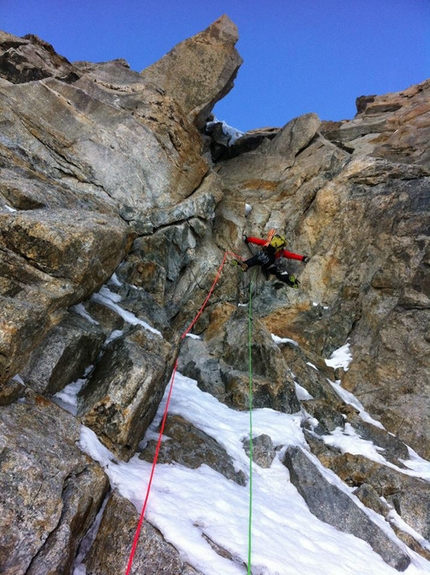
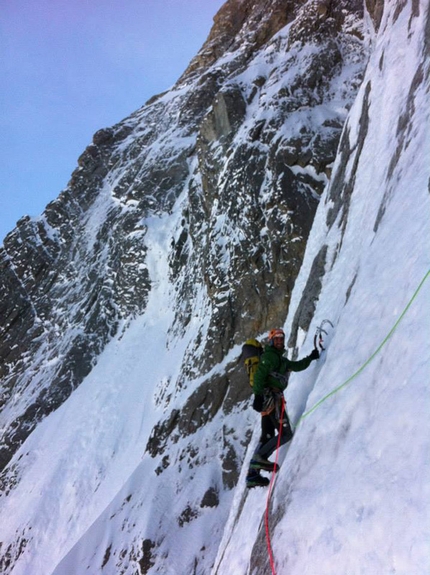
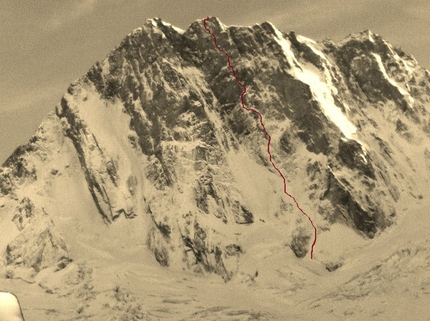
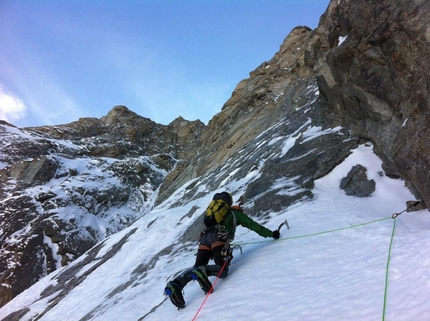
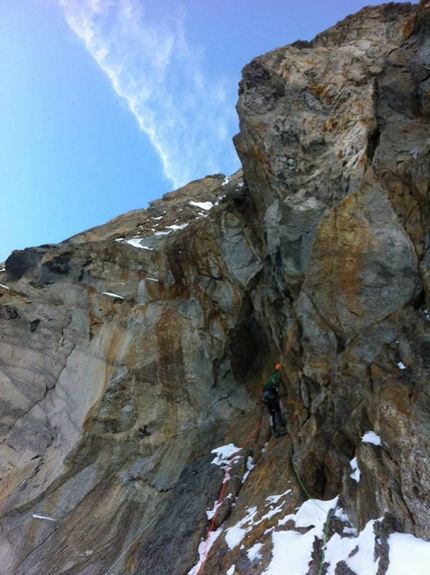
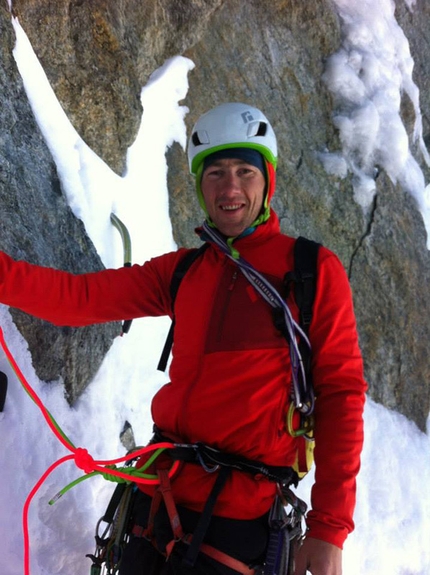
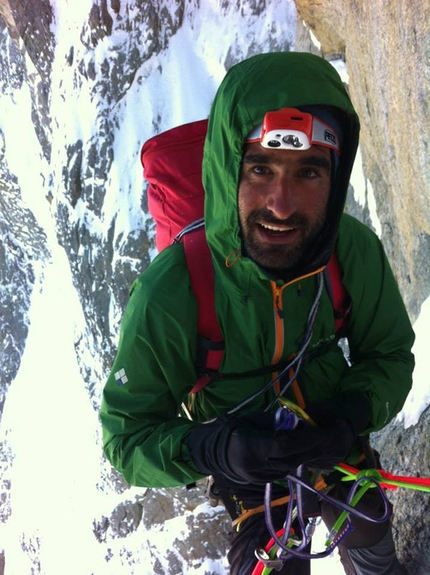
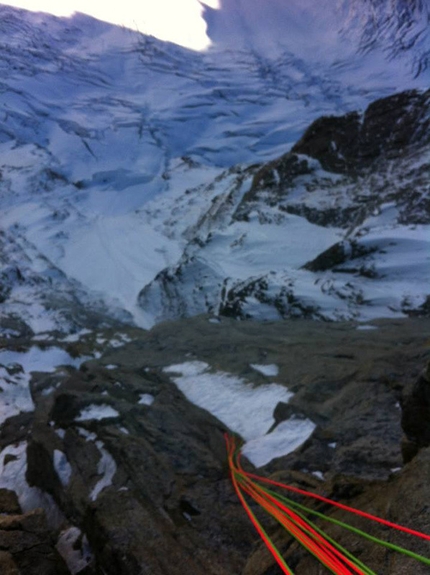
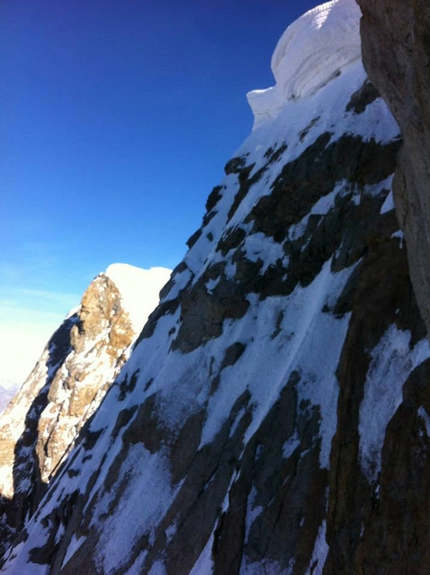

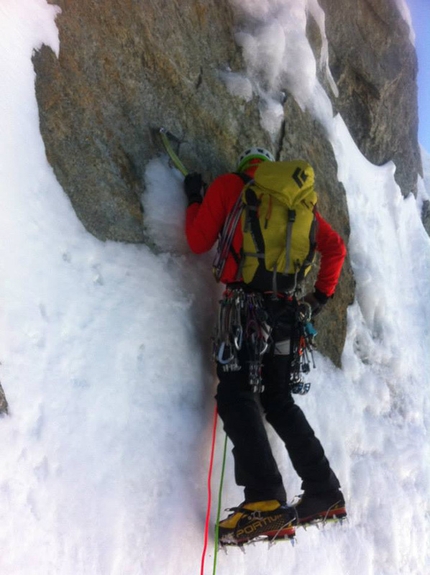
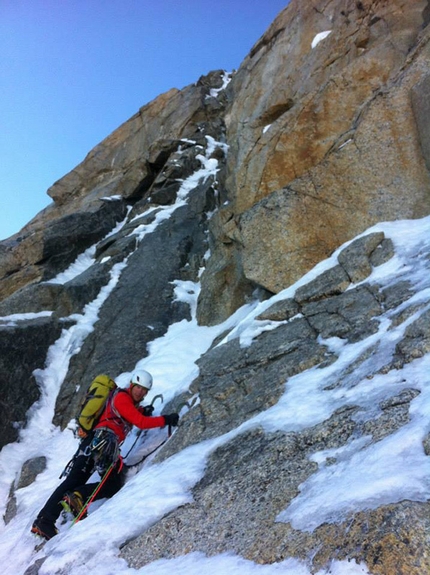
 See all photos
See all photos






















